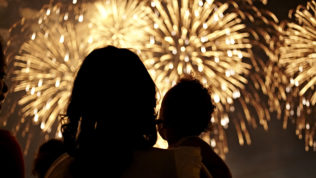It is hard to deny that fireworks during Independence Day are as American as baseball, hot dogs and apple pie! For many people, celebrating our country’s independence includes setting off fireworks on and around the Fourth of July. With the COVID-19 pandemic causing cancellations of some organized fireworks displays, more people will be motivated to set off their own fireworks at home.
While a spectacular fireworks display is both impressive and entertaining, remember that fireworks are explosives best left in the hands of professionals.
Fireworks are classified as hazardous substances under the Federal Hazardous Substances Act. The use of fireworks by consumers is illegal in some states and strictly regulated in all, even where fireworks are labeled for consumer use.
If you are planning to use fireworks to celebrate the holiday, you should first check the legal requirements of your state at the American Pyrotechnics Association and take precautions to remain safe. In its 2018 report on fireworks-related deaths and injuries, the Consumer Product Safety Commission stated that 62% of fireworks-related injuries happened during the 30 days surrounding the July 4 holiday. Between June 22 and July 22, 2018, more than 5,600 people were treated in hospital emergency rooms for fireworks injuries, and five people were killed.
While the numbers vary from year to year, in the last 15 years between 8,500 and 9,800 people, on average, were severely injured each year using fireworks. That doesn’t include an additional 40 injuries reported by the National Fire Protection Association from 18,500 fires started by fireworks, resulting in an estimated $43 million in direct property damage.
More than half of all injuries – linked directly by fireworks and indirectly by fires – involve burns to the hands, head and face that, for some, result in loss of limbs. Most injuries and fires are associated with malfunctioning fireworks or improper use. Malfunctions include unexpected detonations, unexpected flight paths and dangerous debris. Improper use includes igniting fireworks too close to someone, lighting them in one’s hand and playing with lit or used fireworks.
According to the American Pyrotechnics Association and National Council on Fireworks Safety, about 400 Americans each year lose sight in one or both eyes due to “malfunctioning” fireworks.
The U.S. Fire Administration reports that 92% of fireworks injuries involve items considered legal for consumers to use. Sparklers and bottle rockets, for example, are frequently – yet incorrectly – considered safe for young children. Children ages 10-14 face three times the risk of fireworks injuries compared with the general population.
Several organizations, including the NFPA, oppose the sale and use of consumer fireworks. More information about the potential dangers of consumer fireworks are available at the NFPA website.
Fireworks laws vary widely, and warnings issued by the National Safety Council and other agencies advise that the best way to safely enjoy this Fourth of July is to watch a public fireworks display conducted by professionals. Likely in 2020, many displays will still go on with appropriate social distancing.
This loss control information is advisory only. The author assumes no responsibility for management or control of loss control activities. Not all exposures are identified in this article. Contact Landmark Risk Management & Insurance for insurance coverage advice and loss control information.

